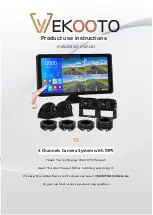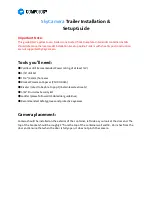
207
k
13.2 Bounce flash with a reflector card
The use of bounce flash with the integrated
reflector card
햹
can bring out highlights in
the eyes of human subjects:
• Tilt the reflector head upwards by 90°.
• Pull the reflector card
햹
together with the
wideangle diffuser
햺
from above out of the
reflector head and forwards.
• Hold the reflector card
햹
and push the
wide-angle diffuser
햺
back into the reflec-
tor head.
13.3 Close-ups / macro shots
In close-ups and macro shots, parallax error
between the flash unit and lens may result in
shadows on the lower edge of the image. To
compensate for this, the main reflector can
be tilted downwards by an angle of -9°. To do
this, depress the reflector release button
햾
and tilt the reflector downward.
If the main reflector is tilted downwards, „
“ is shown on the display to indicate this.
The second reflector is not supported and
does not flash.
Certain minimum lighting distances must be
maintained for close-up shots to avoid over-
exposure.
13.4 Flash exposure memory FE
Several cameras feature a flash exposure
memory (FE; Flash-Exposure). The flash unit
supports this during i TTL flash mode.
It can be used to define and store the expo-
sure level for the subsequent shot before the
shot is actually taken. This can be useful
when, for example, the flash exposure has to
be adjusted to specific details that may not
be necessarily be identical with the main
subject.
This function is activated on the camera.
The subject details for the flash exposure are
measured and brought into focus by the
cameraís AF sensor/metering window.
Pressing the cameraís FE button (the descrip-
tion varies from camera to camera; see
camera operating manual) causes the flash
unit to fire an FE test flash.
The stored metering value, for example „EL“,
is then displayed in the camera viewfinder.
The camera uses the reflected light of the
test flash to determine the light output
required for the subsequent exposure. The
actual main subject can then be brought into
focus with the camera’s AF sensor/metering
window. When the shutter release is pressed,
the picture will be exposed with the
previously defined light output of the flash
unit!
The flash exposure memory FE is not
supported during the green fullyautomatic
programme, the Vari programme and the
subject programmes! Further details regar-
ding settings and handling can be found in
the camera operating manual!
+
Summary of Contents for mecablitz 64 AF-1 digital
Page 54: ...54 j ...
Page 55: ...55 j ...
Page 107: ...107 l ...
Page 159: ...159 x ...
Page 211: ...211 k ...
Page 263: ...263 ö ...
Page 315: ...315 c ...
Page 319: ...c ö k x l j 319 ...
Page 320: ...320 j l x k ö c ...
Page 321: ...321 j l x k ö c ...
Page 655: ...c ö k x l j 329 ...
Page 757: ...97 l ...
Page 805: ...145 x ...
Page 853: ...193 k ...
Page 901: ...241 ö ...
Page 949: ...289 c ...
Page 953: ...293 ...
Page 954: ...294 ...
Page 955: ...295 ...
Page 956: ...296 ...
Page 957: ...297 ...
Page 1123: ...161 x ...
Page 1283: ...c ö k x l j 321 ...
Page 1343: ...55 j ...
Page 1604: ...316 c ...
Page 1605: ...317 c ...
Page 1609: ...321 ...
















































